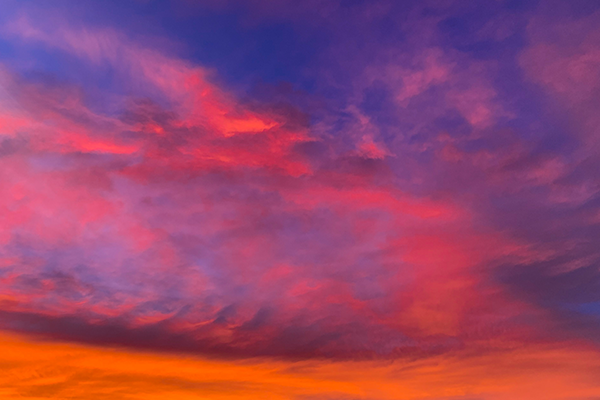
Photo Credit: Lo Arno, Unsplash
I was driving home from work one summer sunset time, and the sky was a dome of golden pink and orange clouds. Cars were parked along the shoulders of the roads, and people were safely leaning against them on the opposite side from the road. A couple of people were lying on the hoods of their car. Other drivers passed by, some annoyed by the congestion. Perhaps they were thinking “I have to get home and do such and such,” thereby missing the present for the future. Or they could have been thinking “I’m so tired and worn out from work” and so trudge on home, prisoners of the past. The rest are outside, surrounded by the glory, in a timeless Now.
Summer Solstice
It’s Summer Solstice. This blog is part of my series on the eight solar and cross-quarter directions. Summer Solstice is focused on Present Time. There are not a lot of high holy days or fasts during summer. Our ancestors were outside during the long days of the growing season. There are a lot of festivals. Being thankful was an integral part of the daily summer rituals of irrigating, harvesting, and tending livestock. In my childhood the evenings were spent outdoors, watering or mowing the lawn, playing hide ‘n seek, talking with neighbors out walking. Summertime had a presence in our lives.
To be present and awake while outdoors is to be attacked by beauty; we are stopped where we stand by the color of a flower, the curve of a stone wall, the fall of water, the sweep of a cloud. A child’s laugh, a baby cuddled, a dog’s ears scratched, a cake coming from the oven are all occurrences that pull us into the present.
In beauty I walk
With beauty before me I walk
With beauty behind me I walk
With beauty above me I walk
With beauty below me I walk
With beauty around me I walk
All is beauty.
— Traditional
One Couple’s Story
A couple were busy city dwellers who were “tired of the rat race”. They quit their jobs, sold their house and moved to Colorado to “get away from it all”. They bought a house that backed onto a greenbelt, and opened a consulting business. All too soon they were spending a lot of time on airplanes. They would promise each other to spend more time together and outdoors “on the weekend”. They would fly in on Friday night, sleep in on Saturday, answer emails and pay bills, shop for groceries. Suddenly Saturday was gone. On Sunday they would pack for the next week, fit church or a Sunday brunch into the morning, and fly out again.
They quickly realized this was the same “rat race”. They decided to take work only in Colorado or neighboring states, and secondly to spend four hours a day in nature and see if and how it changed their lives. Now on weekends they would get up together and watch the sun rise. They had time to get in a hike or a run around the lake. At noon they would take two hours and walk in a nearby park, or sit under a tree. When it snowed enough they would ski around the green belt. They created a garden and spent three seasons a year planting, weeding, watering, and watching the plants grow.
What happened?
“Time disappeared.”
“I am bothered by very little, and upset by nothing.”
“I am earning exactly what I need to earn and saving a little – its sufficient.”
“I am aware of myself as being part of a web of creatures, plants, light and dark, cold and heat. I know the seasons.”
“My body is healthy, limber and strong.”
“I live in the Now.”
Sin Against Loveliness
It seems so much easier in these days to live morally than to live beautifully. Lots of us manage to exist for years without ever sinning against society, but we sin against loveliness every hour of the day.[4]
– Eveyln Underhill
Looking deeper, we see how easy a sin against loveliness might be in our time. Here are two sets of statistics that help us understand what underlies severe problems about living in the Now. The First, let’s discover where most of us live.
85% of the world population may be living in concrete without a single green and growing thing around them. In 2015, H. Ritchie tells us 52% of the world’s population lived in urban centers 33% in urban clusters, and 15% in rural areas, a proportion that is expected to increase to 68% by 2050.

Photo Credit: Thanun, Unsplash
If a person lives in a city or urban cluster, contact with the natural world may be limited to a park blocks away from home, or a small garden, or a rectangle of sky. Also, something else may have changed in the psyche of people living in the cities, perhaps based in the increase of time spent working and commuting. The first time I was in London (1969) as the bus rolled through the neighborhoods each house had a small garden area in front. These obviously tended gardens were individual and beautiful. The last time I was there (2019) many of these plots were brown dirt and trash.
However, today in my USA neighborhood and citywide there are many efforts to protect and increase greenspace. We are experimenting with growing food in hanging gardens between the concrete towers. Laws are being passed forcing developers to include green spaces. These efforts may be hopeful indicators of a recognition of our basic human need to touch the earth.
Screen Time
However, according to March 21, 2022 (Equinox) data from DataReportal, the average American spends 7 hours and 4 minutes looking at a screen every day. This is slightly below average and around 45 minutes longer than the British who average 6 hours and 12 minutes of screen time per day.
Granted, this statistic is at the tail end of Covid stay-in protective measures.
Probably most of us live in the city, and we watch screens. If unable to change the first condition, changing the second one comes down to making a choice: green space or screen space.
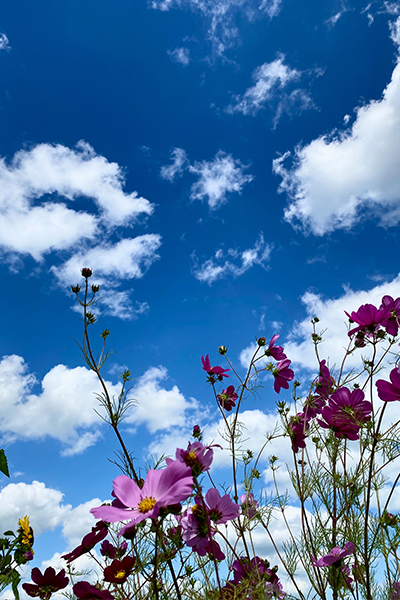
Photo Credit: Paul Engel, Unsplash
Recipes for Being in the Present
- Sit in a room in complete silence. Let the body become aware of the fall of light from the windows, the creaks of the house, the spatial distance of the furniture pieces from each other. Wait beyond the need to get up and do something. Let your thoughts stop. Focus only on what is.
- Lie on the grass and watch the clouds change shape. A winter equivalent would be to stand against a sleepy tree in deep snow, pressed against the trunk, watching the snow fall.
- Pay attention to specifics: “add fresh grated nutmeg”, “turn the lever to the left to start”, “separate the whites from the yolks”, “No U Turns”.
- Eating in the seasonal framework helps bring awareness to Now. The body is aware of the NOW and gives us clues about what makes us feel healthy.
We are alive Now – in this moment we live – not yesterday or tomorrow at this same time. It’s today and only at this moment that we are alive. Be awake to life. Live in this moment, now.
How about you? What are the ways you keep yourself in present time?
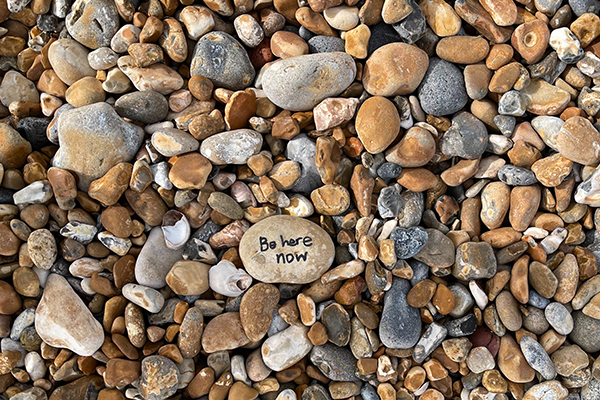
Photo Credit: Shantanu Kulkarni, Unsplash
Please take a moment and tell us how you help yourself stay present in the Now. If we share our “how I do it” we could end up with many new ideas. Our media usage takes us from the Now to a non-reality. Soon we’ll have avatars to do our shopping, or to decide if you really want to read this blog post. It is important to store up ideas and methods on How to Be Here Now. The comment box is at the end of the blog. You can also email me, and I can post your idea or comment if you give me permission.

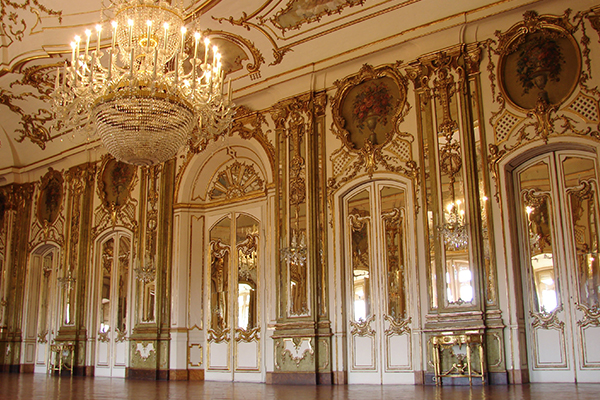
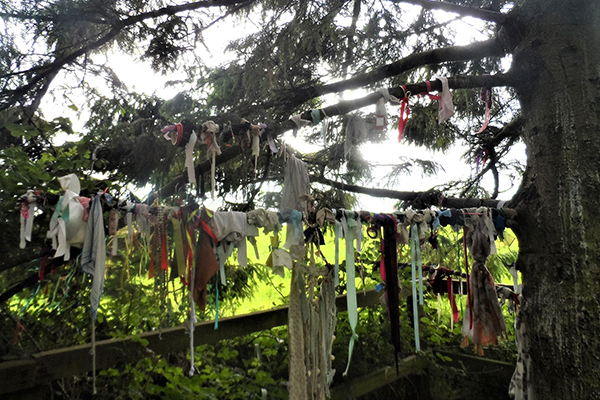
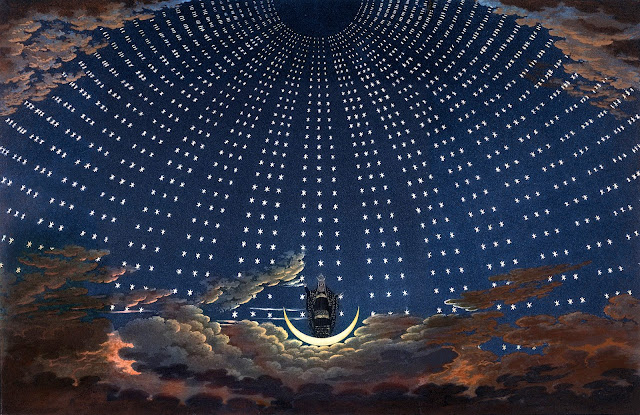

I was fortunate to be introduced to Ram Dass’ book “Be Here Now” in the early 1970’s when it was 1st published. While being in the moment has been more or less difficult over the years depending upon my circumstances, I continue to remind myself of it when I find my mind racing to and fro. Focusing on my breathing helps in this regard and one of the beauties of this is that it can be done no matter where I am. When at all possible I do rely on the splendor of the natural world to bring me into the present…whether it be a walk in the neighborhood, or drive into the nearby foothills, or even just gazing out the window at the trees surrounding my home. I’m truly blessed to have all of these options so close at hand.
Thanks for reminding me about Ram Dass’ book, M.K. “Be Here Now” – that’s it. At Morning Prayer today we were discussing how saying Gratitudes brings you to the present moment also, and offers a boost to optimism.